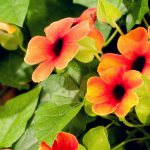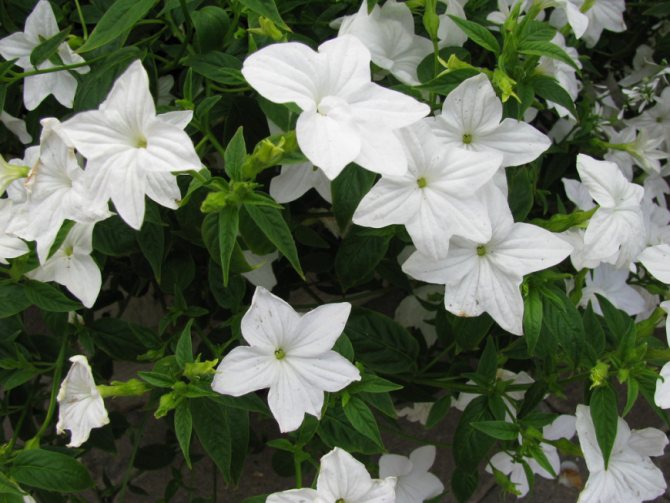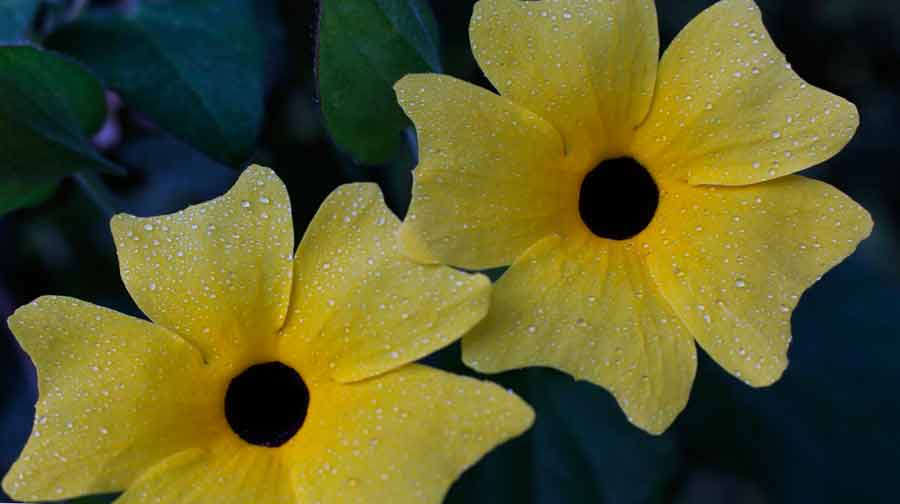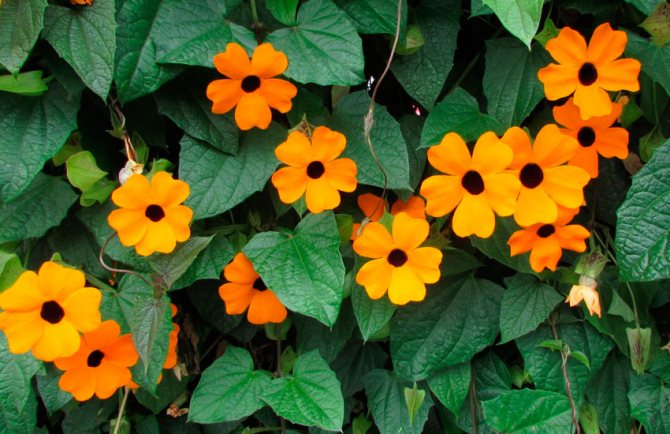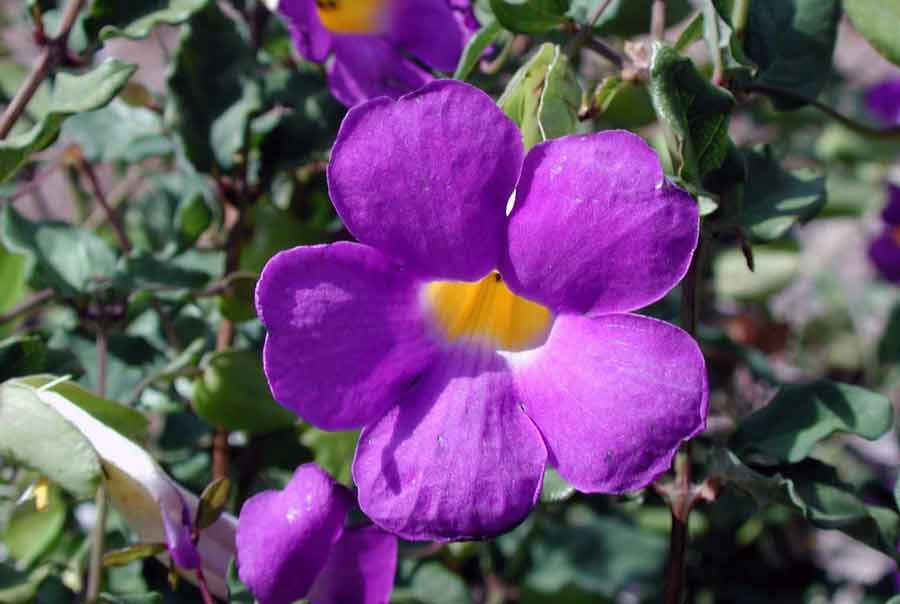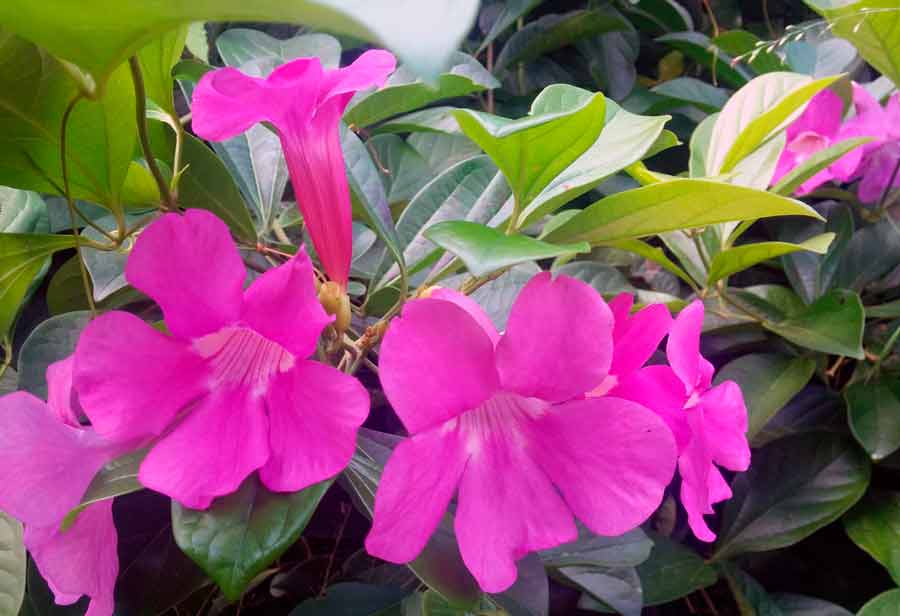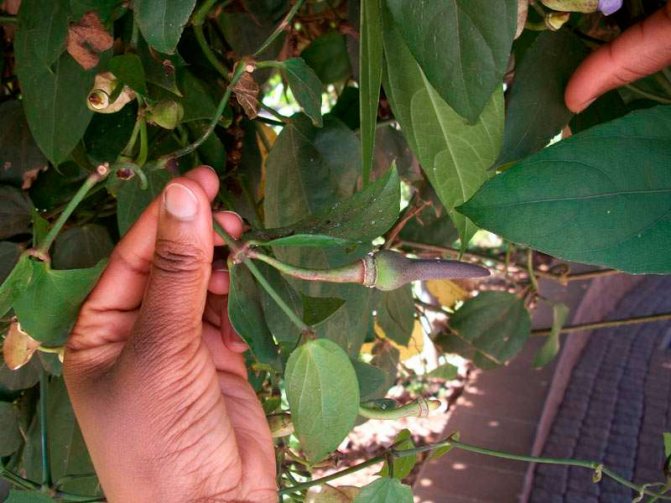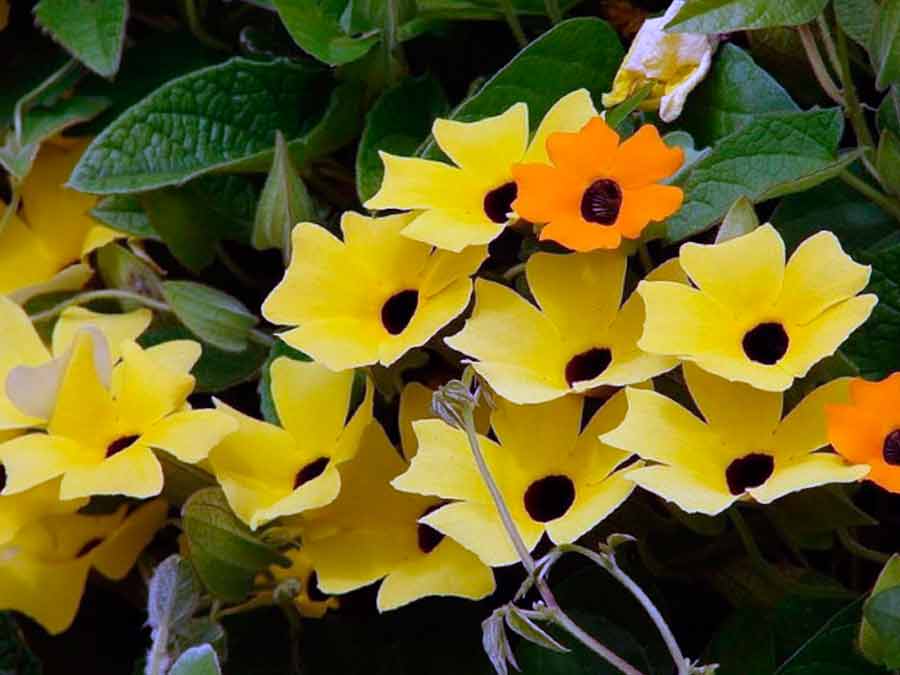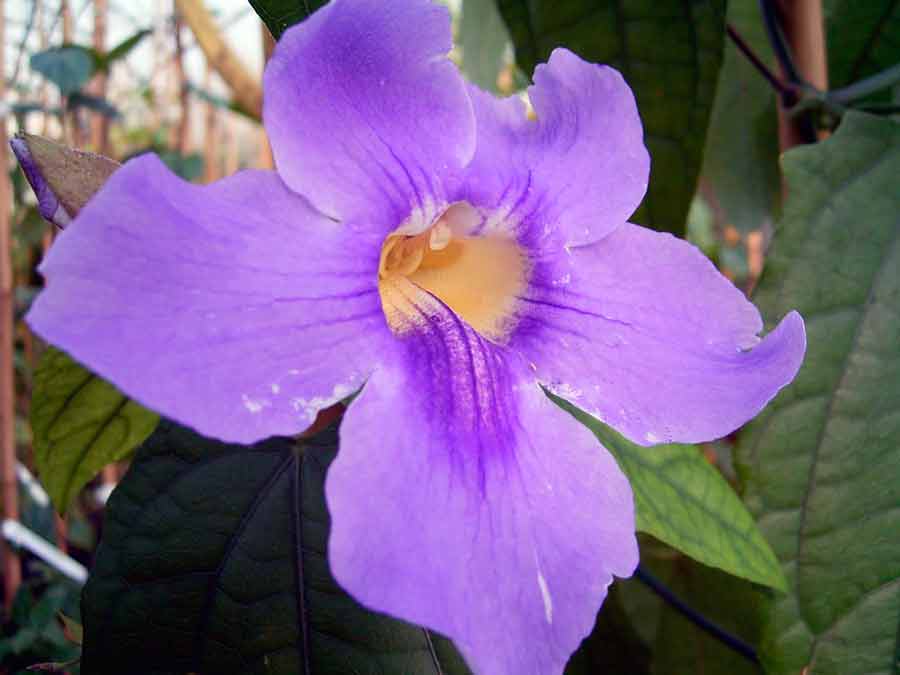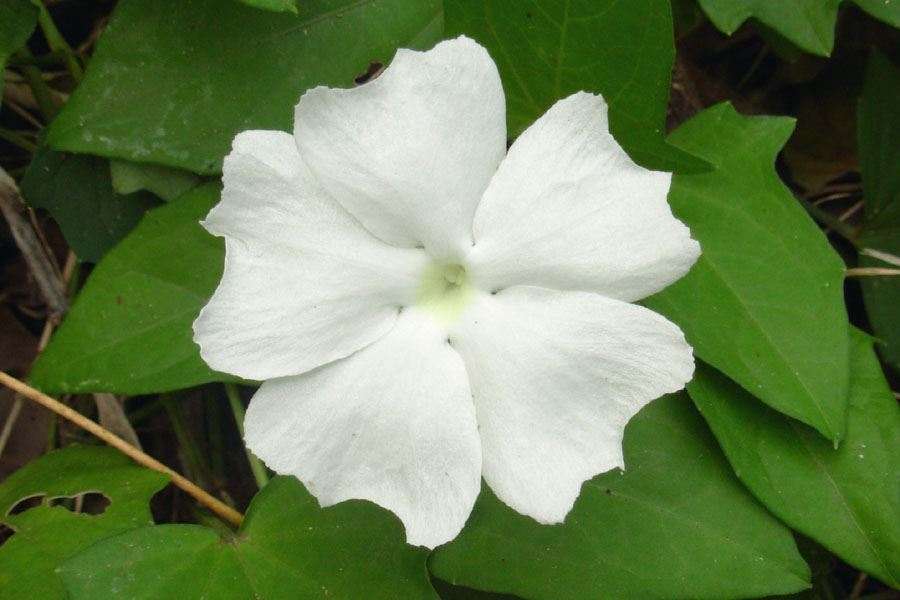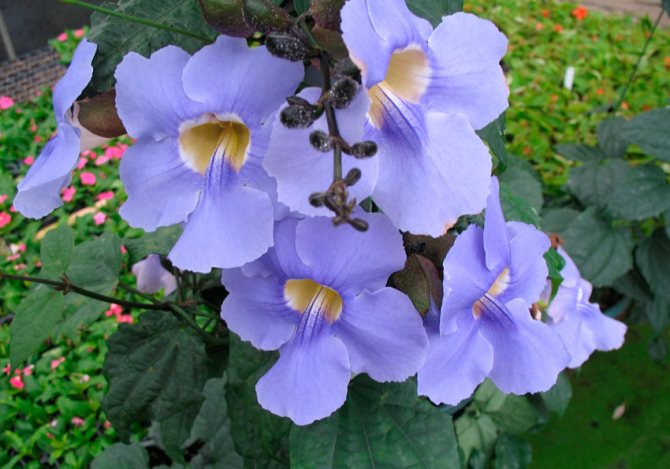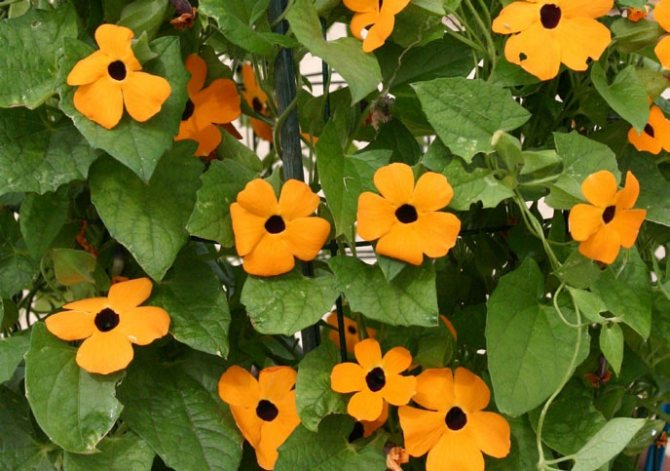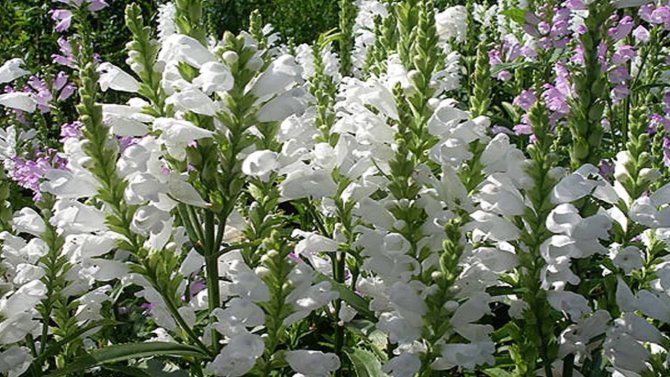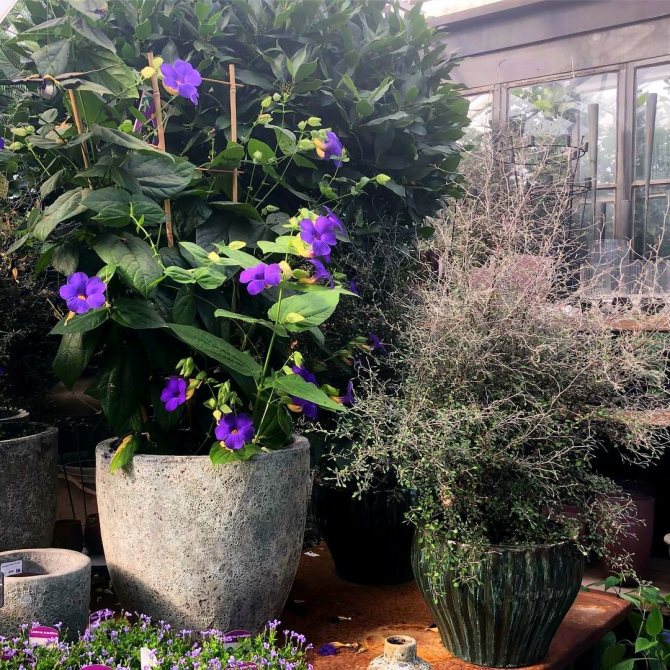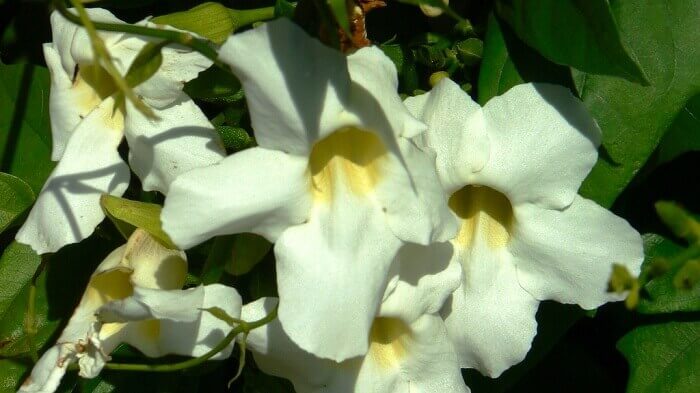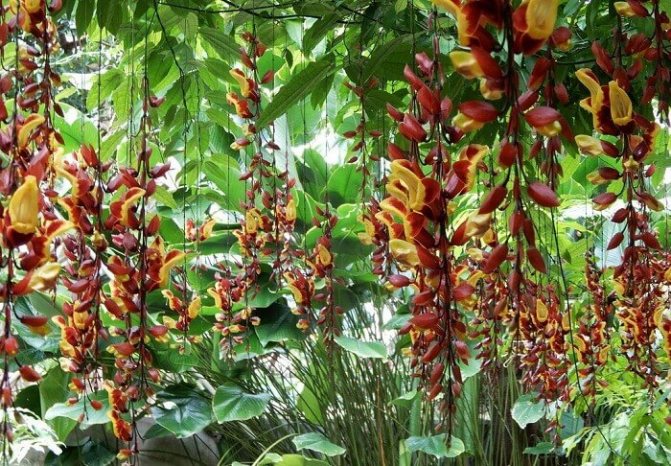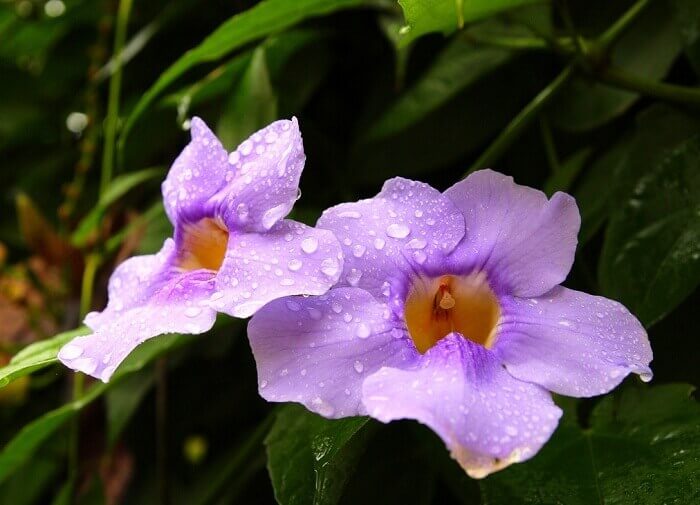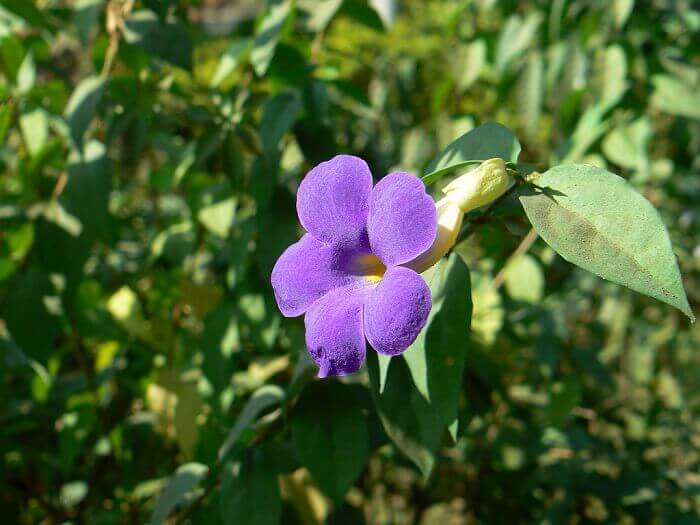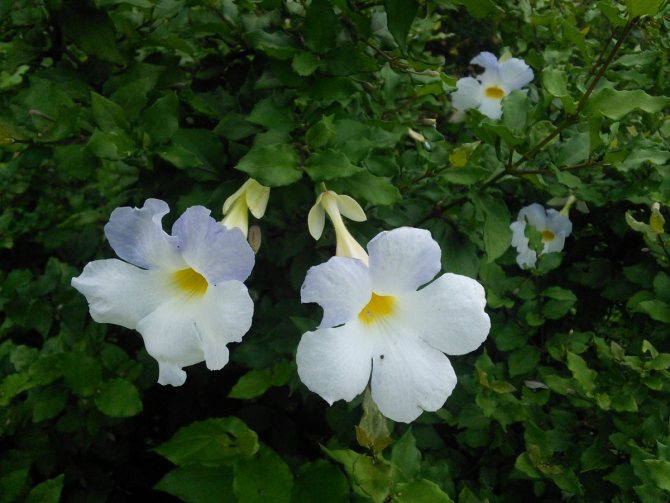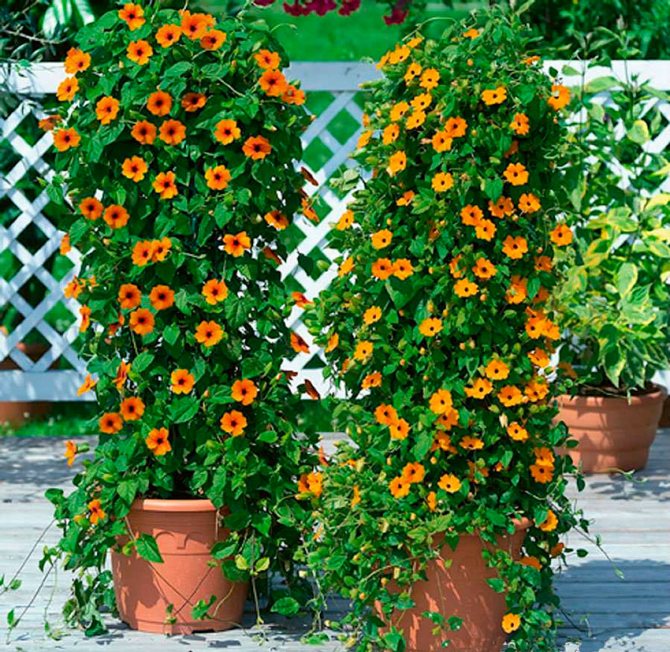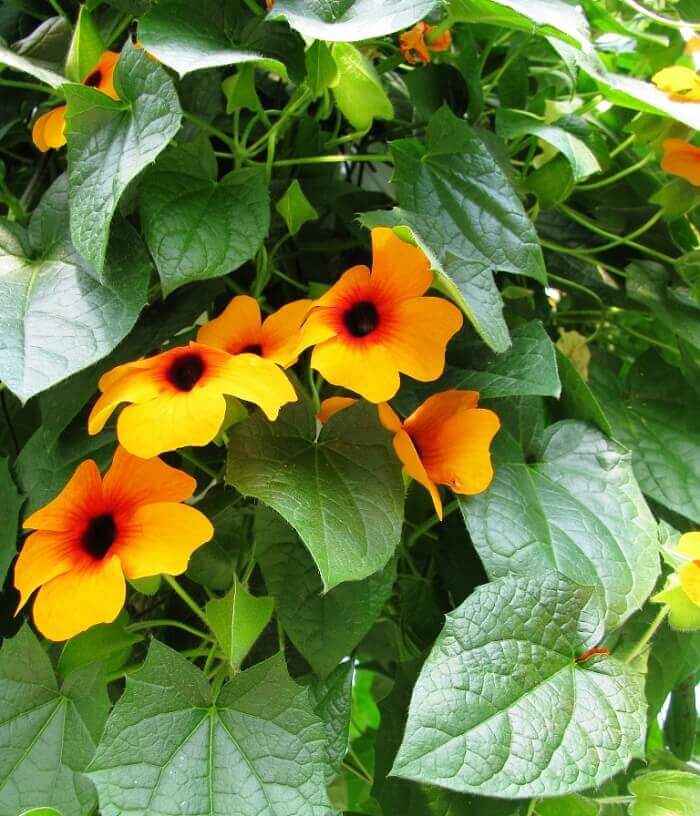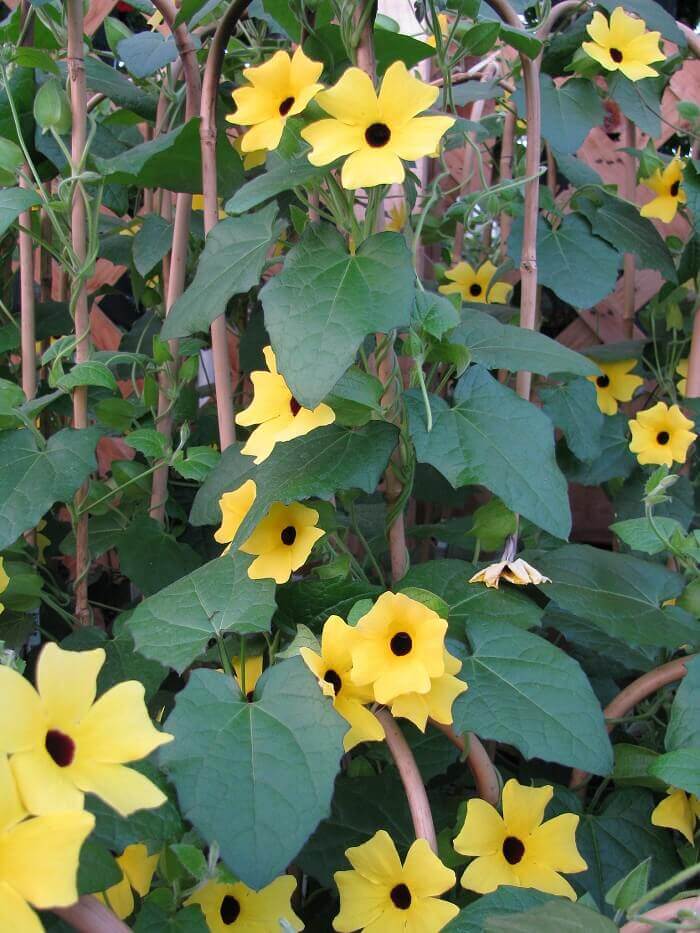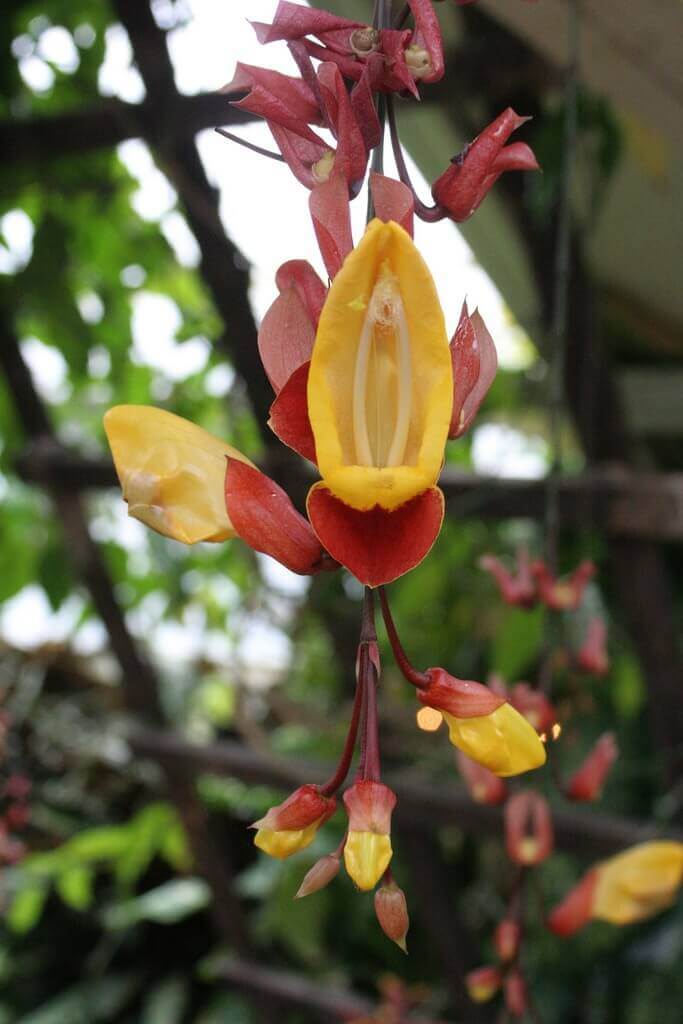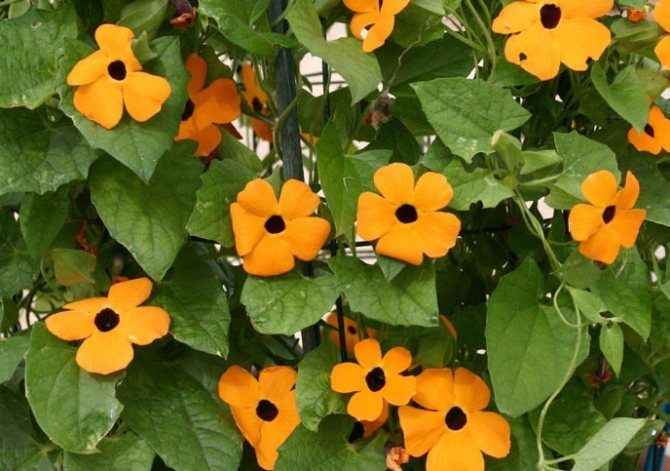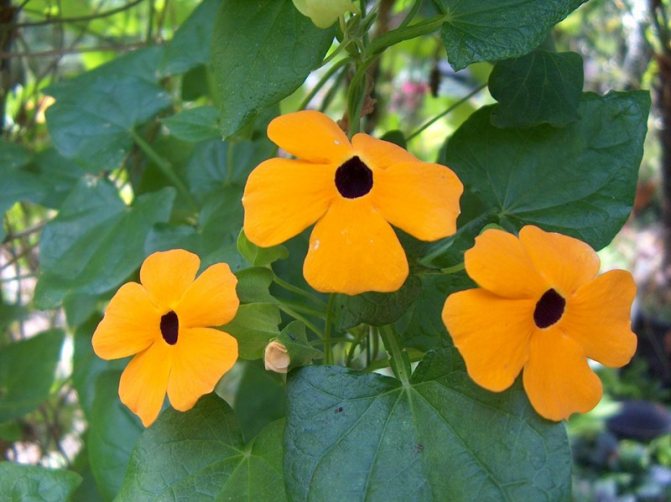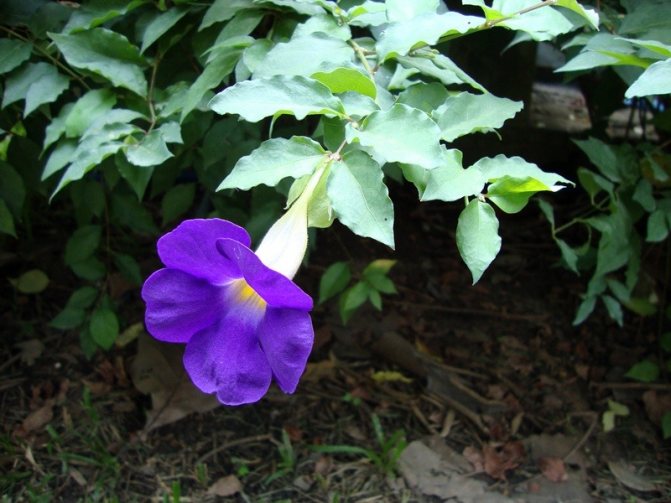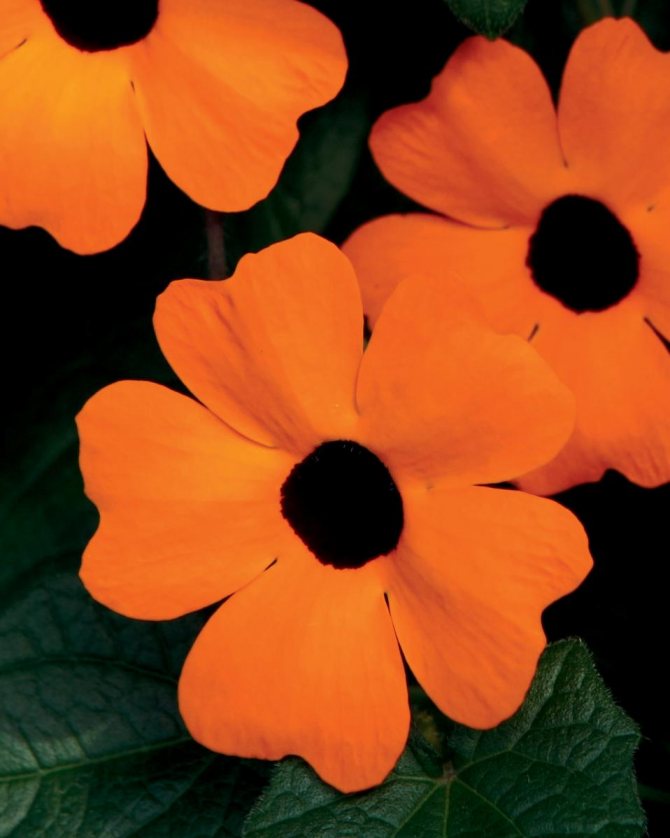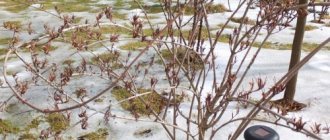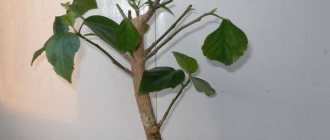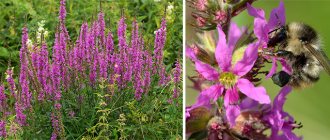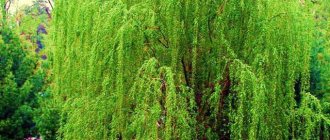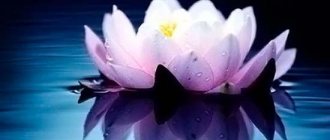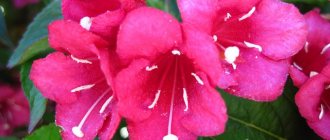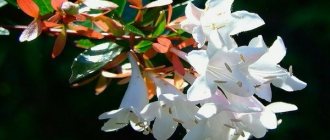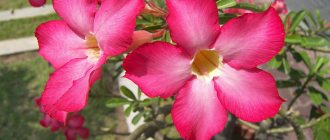Liana Tunbergia (Thunbergia) is a flowering plant and a member of the Acanthus family. Its homeland is the tropics of Africa, southern Asia and Madagascar. This genus unites about 200 species. This plant was named Tunbergia (scientific name) in honor of the Swede Karl Peter Thunberg, who was a naturalist and researcher of flora and fauna in South Africa and Japan. The inhabitants of European countries also call this plant black Suzanne due to the fact that in the center of the flower there is an almost black dark purple eye. It is cultivated as a garden and indoor plant.
Thunbergia winged
Winged thunbergia called "Black-eyed Suzanne" is becoming a popular annual climbing plant, although it grows as a perennial in its homeland .. It is especially readily used for placement on balconies and terraces. Tramline cultivation is the dominant form of cultivation of this species. In the wild, therefore, in Africa, it grows up to 3 m in height. In our climate, it is much lower, usually up to one meter, reaching a maximum of 1.5 m.

Sinuous, creeping shoots climb the fences (lattice, fence, railings). If you put a flower in a hanging basket, it will have a hanging (crying) shape.
Leaves are opposite, serrated, planted on long petioles, from oval to heart-shaped. In the axils of the leaves, decorative flowers appear already in June, which bloom until frost.
Nirembergia for your garden: types, descriptions, planting and care secrets
Home ›Flowers and plants
14.02.2019
Cup-shaped flowers of white or various shades of blue and purple adorn the sun beds all summer long.
The herbaceous perennials described below can grow on any garden soil, preferably in humid but sunny places.
Nirembergia. The illustration for the article was taken from the Internet.
All of these species can be grown in containers to create striking edging for patios or terraces. Two species, Nierembergia caerulea (Nirenbergia blue) and N. scoparia (N. paniculata), are quite thermophilic plants, and they are usually grown as annuals, every year from seeds or from overwintered cuttings. Homeland -Yu. America.
Recommended species and varieties
Caerulea (syn. N. hippomanica) (N. blue)
This perennial with a woody base from early summer to early autumn is covered with lilac-blue or pale purple flowers about 2 cm wide, with a yellow throat. Thin branching stems bear small pointed leaves up to 8 cm long. This is a very ornamental plant for a rock garden or foreground border. The height and diameter of the plant is 30x20 cm.
Perennial with a woody base. Illustration for the article taken from the Internet
Frutescens
This plant forms a low carpet of light green spatulate leaves up to 3 cm long. In the first half of summer, a mass of white cupped flowers with yellow eyes about 3 cm wide bloom. The species tolerates temperatures up to -10 ° C. The height and diameter of the plant is 5x60 cm.
Frutescens. The illustration for the article was taken from the Internet.
"Violet Queen"
The cultivar looks the same, but the flowers are dark purple.
The flowers are dark purple. The illustration for the article was taken from the Internet.
N. rivularis
This bushy plant is similar to N.caerulea, but slightly higher, with narrower leaves and flowers in a range of shades from light lilac to dark purple. The height and diameter of the plant is 36x20 cm.
Bushy plant. The illustration for the article was taken from the Internet.
Growing
Plant the seedlings in the spring in well-drained soil in a warm, sunny location. Propagate heat-loving species by sowing or remove for the winter in a greenhouse. N. repens grows best on dry sandy soil and may overgrow.
Reproduction
Heat-loving perennials easily reproduce either by summer cuttings or by spring sowing under glass. In the greenhouse, the bushes can be divided in the spring.
Pests and diseases
Aphids and whiteflies can harm plants under glass; in the garden, they are damaged by slugs and snails.
Nirembergia for your garden: types, description, secrets of planting and care Link to the main publication
Tunbergia grandiflorum
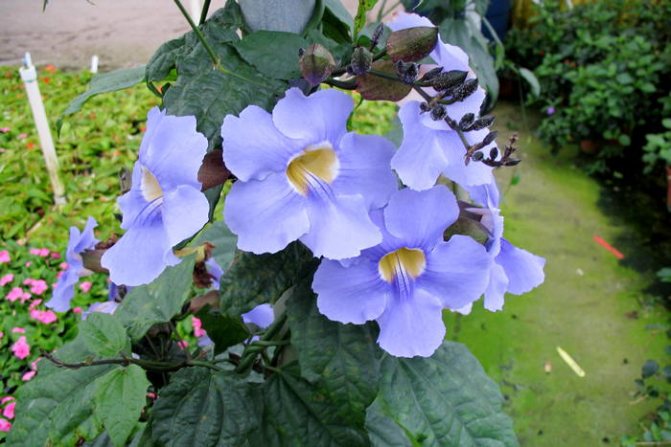

A rare species of the genus Thunbergia, also grown on the balcony and terrace, is Thunbergia grandiflora. In its native places, it is a high-climbing, perennial creeping plant, but in our climate, due to the cold winter, it is an annual plant that can overwinter. The large-flowered tunbergia delights with blue flowers with a yellow center. Reaching several centimeters in length, they look beautiful against the background of large, up to 20 cm long, heart-shaped leaves.
Types and varieties of tunbergia
Cultivated vines are represented by the four most popular types.
Thunbergia fragrant is an evergreen liana that grows up to six meters. Above, its ovoid leaves are dark green, and below - light green with a white vein in the middle. Single flowers up to 5 cm in diameter have a white tint and a pleasant aroma.
Tunbergia large-flowered or blue is distinguished by curly shoots and bright green leaves with large teeth at the edges. Small-flowered inflorescences consist of purple or blue flowers with a white spot in the pharynx.
Thunbergia Battiskomba is a liana with wide leaves and blue flowers, on the petals of which a mesh is clearly visible.
Thunbergia winged or Black Suzanne is a very popular annual plant. Its long, liana-like stems are strewn with single flowers of various shades. In the center of each flower there is a dark purple eye, which is why this type of plant was named "Black-eyed Suzanne". The most famous and used for decorating the plot are the tunbergia winged varieties:
- Susi Yellow cultivar - liana growing up to three meters, which is easiest to grow from seeds. The plant is so covered with numerous flowers that the leaves are practically invisible.
- African Sanset variety blooms throughout the season with flowers of an unusual terracotta shade.
- Tunbergia group Gregorii consists of 12-15 varieties, each of which blooms with its own shade of orange. It is distinguished by the absence of a black eye, however, it still looks very attractive.
Requirements
The flower prefers a sunny place protected from the wind, in case of extreme heat - shaded. When growing vines at home, you should provide it with a clear place, best near a window.
Prefers warm places. Grows well at home at room temperature. Outdoors in the open field should not be exposed to large temperature fluctuations. For the winter, the flower should be transferred to a bright and frost-protected room. The temperature should be approximately 5-10 ° C.
Since the vine is characterized by a large green mass and abundant flowering, it requires good soil, saturated with nutrients. When growing in containers, choosing the right soil is the foundation for success. The soil should be fertile, humic, permeable, and calcareous.The substrate should be supplemented with, for example, fine gravel to ensure the appropriate level of permeability and prevent root rot. You should also remember about drainage.
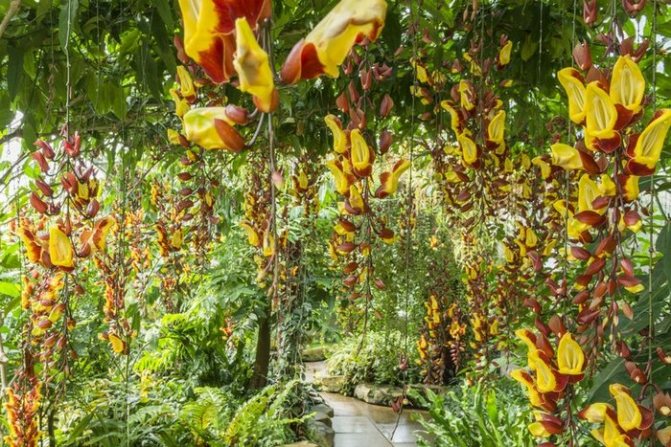

Growing tunbergia from seeds
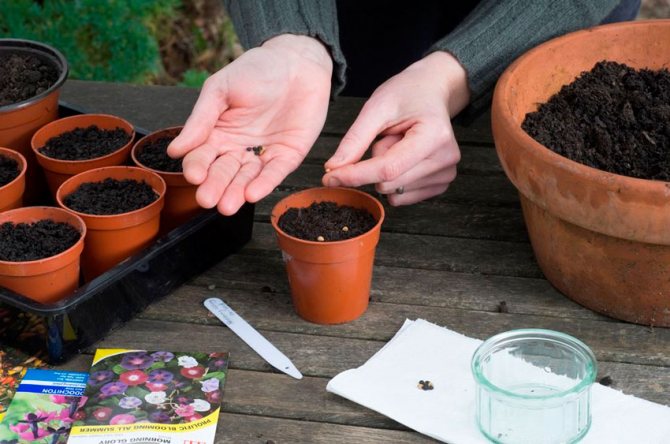

Sowing
It is necessary to sow tunbergia seeds at the end of winter or at the beginning of spring. Immediately before sowing, the seeds must be treated with fumar or epin. Then sowing is carried out in a container with a moistened soil mixture, which includes peat, turf soil, sand (or sand, leafy earth and humus), which must be taken in a ratio of 1: 1: 1. Seeds should be sprinkled with a thin layer of substrate, and then the crops are carefully watered. Then the containers should be covered with foil or glass and placed on a windowsill, which should be well lit, but do not forget to protect crops from direct sunlight. Remember that the substrate in the containers must be constantly slightly moistened. In order for the seedlings to appear as quickly as possible, they should be placed in a place where the air temperature will be in the range of 22 to 24 degrees. If everything is done correctly, then the first shoots can be seen within 7 days after sowing. Once this happens, remove the cover.
Seedling
If the seedlings are excessively dense, then after the formation of 2 true leaf plates, it will be necessary to thin them out, while the weakest seedlings should be removed. You can also pick them. In order for the bushes to be more branched and dense, the seedlings are pinched after their height is 12-15 centimeters. In the event that it is important for you that the bushes have a lush green mass, then after you make a pick, feed the plants once every 7 days with fertilizers containing nitrogen. Those who value long and abundant flowering should take into account that seedlings do not need to be fed at all. In order to avoid picking, sowing is recommended to be carried out in peat cups, while 3 seeds should be placed in 1 at once.
Care
When growing tunbergia, attention is primarily paid to watering and fertilization. The needs of plants in this plane are significant. They like humidity and should avoid dry air, especially at home. Watering is done quite abundantly, but depending on the prevailing conditions, it is not necessary to overflow, the flower does not like a wet substrate. Do not overdry the substrate, this will limit the growth of the plant.
Top dressing is regular, liquid multicomponent fertilizer every 7 days to replenish nutrients from the soil, which are not enough in the container. When grown outdoors, it is sufficient to fertilize every two weeks. Mineral fertilizers should be supplemented with organic fertilizers.
In the case of wintering, the tunbergia is cut off in the spring and transplanted into a new substrate.
Caring for erect tunbergia at home
This is not the easiest plant to care for, but you cannot call Tunbergia capricious. Standard watering and feeding, regular pruning, and removal of wilting flowers are just a few of the essential care items. To avoid problems with the plant, you just need to closely monitor it, noticing any deviations from the norm.
Watering and air humidity
For upright tunbergia, a standard watering strategy for all crops with a pronounced dormant period is fine. Throughout the entire phase of the active growing season, tunbergia are watered abundantly, preventing water from stagnating in the pallets and drying only the top layer of the soil. After the end of flowering, or, even if it continues, with the arrival of autumn and a decrease in the duration of daylight hours, watering is gradually reduced. And by the time of transfer to the cool, the plant is transferred to a light moisture content of the substrate.
But letting the substrate dry out completely throughout the year is not a good idea.Tunbergia erect during a drought partially sheds its leaves, although it recovers quite quickly, but significantly loses its decorative effect. The average frequency of watering for this plant is up to 4 times a week in summer and 1 time in 2 weeks in winter.
Tunbergia erect prefers medium humidity; in a very dry environment, its leaves suffer. But there is no need to raise the indicators by installing permanent humidifiers. The optimum moisture content is about 50-60%. Typically, a simple leaf spraying is sufficient for this crop. During flowering, these procedures must be carried out very carefully so that drops of water do not fall on the buds and blossoming flowers.
The leaves of this type of tunbergia can be wiped off dust with a damp sponge.
Top dressing and composition of fertilizers
Fertilizers are applied to the water for irrigating tunbergia only during the active growth phase and until the end of flowering. If flowering continues in autumn or winter, then the fertilizing is halved. In spring and summer, they are applied with a frequency of 1 time in 2 weeks.
Tunbergia erectus reacts equally well to both mineral and organic fertilizers. For this, plants use universal fertilizers with a balanced composition of elements. Indeed, with an insufficient amount of nitrogen, the plant will not release the mass of leaves that is so necessary for a lush crown.
But you should not use pure nitrogen fertilizers for it, preferring complex preparations. During the budding period, you can carry out several dressings with fertilizers with a high potassium content.
Pruning and shaping upright tunbergia
Most tunbergia lianas are pruned quite hard after flowering. Erect thunbergia can only be cut off easily, no more than a third of the length of the branches, and at completely different times. If you do not carry out regular annual pruning, in the third year the bushes lose their decorative effect and need to be replaced with new plants. Cardinal pruning on this tunbergia is not carried out and does not give results.
It is best to prune in the third decade of February or early March, before the plant begins to grow and transplant. The main task of pruning is to stimulate more abundant flowering on annual shoots.
As with any other plant, sanitary pruning is also mandatory for tunbergia - cutting out weak, damaged, unproductive and oldest branches.
The formation of a plant into more compact bushes should be started from the first year, so that you do not need to cut the branches too much to maintain their shape in the future. Neat strict figures cannot be created from this bush. Pinching the shoots stimulates the thickening of the plant.
Despite the status of the shrub, tunbergia is erect, especially if the plant is large and has not been restrained in growth, most often it needs support to maintain an erect shape. Installation of grids or circular supports is needed only for tunbergia, the height of which exceeds 60 cm.
As in the garden tunbergia, on the room erect tunbergia, you should regularly pinch the fading flowers, since the formation of seeds stops flowering.


As in garden tunbergia, on room erect tunbergia, you should regularly pinch the fading flowers.
Planting, containers and substrate
This plant does not require annual replanting. Only very young plants are transplanted annually in the first two years. For adult tunbergia, transshipment with a frequency of 1 time in 2-3 years is sufficient.
For tunbergia, medium-sized, standard containers with a height slightly exceeding the diameter are used. Drainage holes are required.
Thunberg erectus can be grown only in loose, permeable and nutritious soil. When choosing ready-made substrates, it is worth stopping at special soil mixtures for trees and shrubs or a universal substrate with a coarse texture.If the soil is mixed independently, then it is better to prefer a simple soil mixture of equal parts of humus, sand and sod soil. For this plant, only neutral or slightly acidic substrates are suitable.
If it is necessary to install supports for the plant, this is done before transferring it to a new container. High drainage is laid at the bottom of the tanks. The soil is not strongly compacted during transplantation.
Support
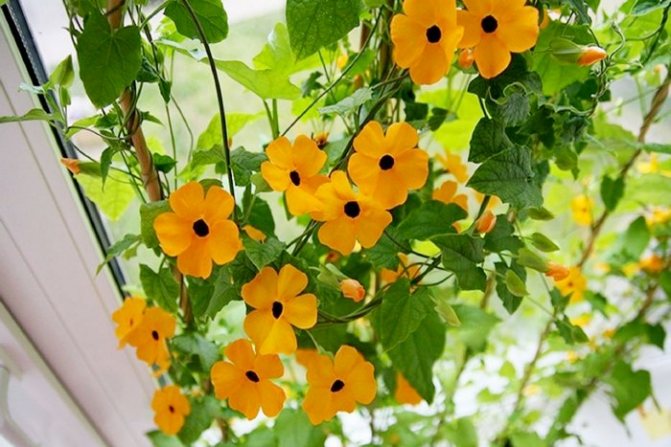

For tunbergia to create a green wall, you need to provide it with good support. In principle, it wraps well around trellises, balustrades, fences, bamboo poles. To make it creep, you can put a flower pot in a hanging basket. Bouncing in the wind, the blossoming tunbergia shoots will look picturesque.
Remember, young specimens are equipped with supports at the moment when they produce the correct leaves.
It is important that the supports are firmly attached, especially with a large surface area. When creating a green wall, they are exposed to large gusts of wind, with poor fastening, overturning may occur.
Flower use
Thunbergia is actively used both for landscape design in the garden area and as decoration for home interiors.
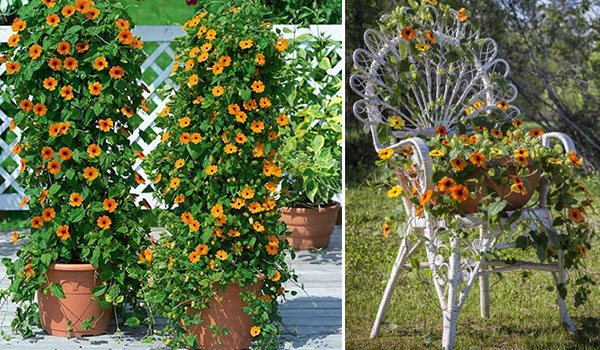

The most advantageous ways of positioning in the garden:
- Along the fence or wall of the house.
- As a decorative fence inside the site, pre-setting the grid or support.
- Growing tunbergia near a single support 1–1.5 meters in height will help to revitalize individual areas without shading the ground too much. Then the stems will twine around the peg, and flowering branches will hang from above by the end of summer.
- By planting seeds along the south side of the greenhouse, the plants will be shaded from the direct sun.
- When creating a flower bed, tunbergia will look good at the base of an alpine slide, growing between the stones into beautiful climbing streams. Even along the lawn they look interesting small fountains from hanging tunbergia.
- In hanging pots on the walls of the house. In this case, it is important to regularly fertilize the soil and prevent it from drying out.
In the apartment for the first time it is possible growing in a pot on a windowsill or balcony... When the flower begins to grow, all its beauty will unfold in hanging pots, from which green or flowering branches will hang.
Tunbergia is a rather unpretentious plant that can be admired all year round in an apartment or on a garden plot, creating flower arrangements.
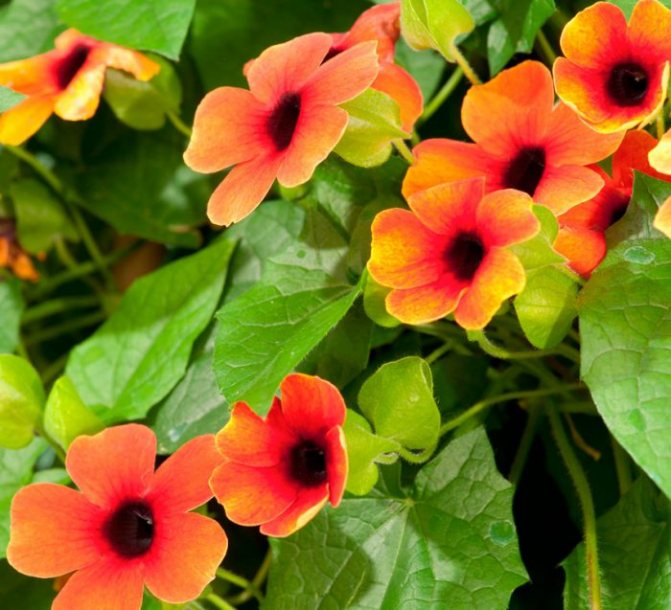

Liana Tunbergia (Thunbergia) is a flowering plant and a member of the Acanthus family. Its homeland is the tropics of Africa, southern Asia and Madagascar. This genus unites about 200 species. This plant was named Tunbergia (scientific name) in honor of the Swede Karl Peter Thunberg, who was a naturalist and researcher of flora and fauna in South Africa and Japan. The inhabitants of European countries also call this plant black Suzanne due to the fact that there is an almost black dark purple eye in the center of the flower. It is cultivated as a garden and indoor plant.
Reproduction
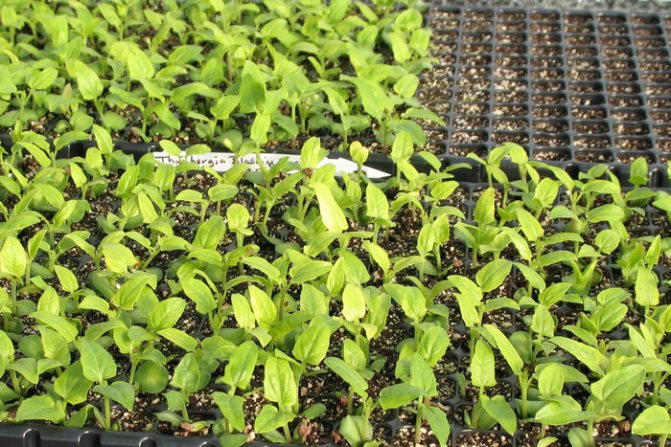

Thunbergia is best propagated by seeds. Seedlings are prepared in early February or March by sowing several seeds in a pot or boxes. It is necessary to provide a bright place with a temperature of 15-20 ° C. Young shoots dive into pots, as they get older, pinch off the top for better growth. In the second half of May, the plants are brought out to the balcony and terrace, but before that they are tempered.
You can try to propagate Tunbergia vegetatively, using apical cuttings taken in the summer.
Flowering period
Tunbergia blooms in summer and early autumn with ribbed flowers. The most exuberant flowering occurs in August. Withered flowers must be removed so that they do not set seeds. To date, many hybrids of this plant have been bred.They differ in flower structure and color.
When the time of flowering ends, fruits in the form of boxes with seeds begin to form in place of flowers. Their contents must be collected before they open and spill to the ground. Fresh seeds are dried on paper and stored in cardboard boxes. They remain viable for two years.
The most common problems
Thunbergs are decorative lianas that will bloom beautifully and profusely if their requirements are met. Very often there are many problems when growing vines, which, unfortunately, are the result of our negligence.
Weakened plants easily fall prey to whiteflies, spider mites and aphids. Dry air and lack of moisture contribute to the appearance of pests.
Too elongated stems and pale leaves are a sign of too dark places. In the shade, do not count on lush bloom.
Faded leaves are a sign of dry soil, especially during hot days. The moisture content of the substrate should be controlled, tunbergia does not like overdried soil. In such conditions, the leaves wilt and turn yellow, and the growth of the plant slows down.
Too wet substrate is manifested by yellowing and wilting of the leaves.
How to grow nirembergia in a country house in the Moscow region: planting and care
Nirembergia is a graceful plant with a compact crown and abundant flowering. In its native Argentina, it grows as a perennial plant. The first work on cultivation was carried out from the 30s of the XX century, by the Spanish botanist Niremberg, in whose honor the flower was given its modern name. At the moment, the world knows about 30 types of nirembergia. In Russia, the plant is grown as an annual, since the heat-loving flower is unable to withstand severe winters.
Growing methods in the Moscow region
Reproduction of nirembergia is carried out mainly by seeds. Sowing is done in March. The seedling boxes are filled with a nutrient medium suitable for the growth of flower crops. The surface of the box is covered with cling film to maintain the moisture level of the substrate.
The first shoots should be expected in one and a half to two weeks. In the phase of 3-4 true leaves, seedlings dive into individual containers with a diameter of at least 5 cm.
The method of grafting twigs of an adult plant is no less effective. The slices should be 10-15 cm long. The cuttings are placed in water, which should be changed regularly. The formation of the root system occurs after two weeks.
The choice of planting material
For a successful purchase of high-quality planting material, you should contact a specialized store, where you can get advice on growing and caring for the plant.
Seed material has the highest percentage of germination in the first two years after production, so an important factor when making a purchase is the expiration date.
Popular varieties
Among summer residents and flower growers near Moscow, the following types and varieties of nirembergia are most popular:
- Frutescence. Creeping nirembergia, forming a dense fabric, up to 10 cm high. The diameter of the flowers reaches 3-4 cm. The green mass is juicy, emerald in color. The variety of shades allows you to use this species as an independent decorative composition, or for decorating borders and garden paths. Able to withstand frost, down to -5 degrees.
- Violet Queen. Possesses the qualities inherent in Frutescence, however, it is distinguished by a rich, dark purple color.
- Nierembergia rivularis (tamed). A plant with a dense, bushy crown of sharp-needle leaves. The color range of the species ranges from light purple to deep purple shades.
Soil preparation
Nirembergia seedlings are planted at the end of May, when the threat of spring frosts has passed. Before landing, you need to make some preparations.The place for nirembergia is chosen sunny, since partial shade adversely affects the quality and intensity of flowering.
The soil for a flower needs nutritious, loose. For the comfortable growth of seedlings, the earth is dug up, drained with overripe straw, peat, humus and sand. Preliminary application of complex mineral fertilizers is encouraged, however, it is enough to select the area where fertilizers were applied last season.
If we talk about the neighborhood, then nirembergia is perfectly combined with other decorative cultures.
Landing in the ground
When transferring seedlings to a place of permanent growth, you should first prepare the planting holes located at a distance of 20 cm from each other. Given the intensity of crown development, this distance will be sufficient to form a dense, uniform flowering canvas.
The root system of the seedling is weak, therefore, when transferring material to the ground, a near-root earthen lump should be captured.
After planting, the seedlings are watered abundantly with warm, settled water.
Care during growth
Further care of the plant consists in regular watering, loosening the topsoil, and also killing weeds.
Since the flowering of nirembergia continues from early July until the onset of the first real frosts in October, so that the growing season is not interrupted, it is necessary to apply complex mineral fertilizers. Top dressing is done every two weeks, in the evening or morning, followed by abundant watering.
Watering is carried out as needed. Fortified plants, which are prone to growing in the hot conditions of Argentina, are able to withstand prolonged drought.
Pests and diseases
Unpretentious nirembergia has sufficient resistance to pathogens of plant diseases. However, if the correct agricultural practices are not followed, the flowers are exposed to fungal diseases. For example, basal stagnation of water can provoke the development of rot.
Of the insect pests, the most dangerous are:
- Whitefly. Mole-like insect that feeds on plant sap. With an intensive growth of the population, it leads to drying and falling off of the green mass.
- Aphid. A gnawing and sucking insect capable of destroying a plant in the shortest possible time.
Upon detection of the first signs of the appearance of pests, it is necessary to process with specialized chemicals:
- Aktara. The prepared solution is poured over the roots. Leads to the complete destruction of adult insects, however, requires re-carrying after 10 days.
- Akarin. The entire plant is sprayed, as well as nearby bushes and other horticultural crops.
- Sparks. The drug has an effect on the destruction of pests within 15-20 days after treatment.
Preparing the plant for winter
Seeds are collected by the end of the season. Ripe flower heads are cut off and dried in a dry room on a cotton cloth.
Before the onset of strong autumn frosts, the plant can be transplanted into a container and transferred to the house for subsequent room maintenance.
With proper care, nirembergia can bloom until next spring. Indoor winter maintenance will help to obtain planting material in an easier way than seed. Closer to spring, an adult plant is pruned and the cuttings are placed in water for rooting.
Keep the link to yourself so as not to lose it!
Watering
Thunbergia should be watered with soft water at room temperature.
Watering should be regular: in the summer during the flowering period - 2-3 times a week. At this time, the plant especially needs good watering, the soil should always be slightly moist.
Due to overdrying, buds and flowers may drop. However, waterlogging should also be avoided - water from the sump is poured out 20-30 minutes after watering.
Since autumn, the frequency and volume of watering are slightly reduced. In winter, the soil should be moistened every 10-14 days, after the top layer of the soil dries well.
From time to time, especially on hot summer days, it is recommended to spray tunbergia once a day, in the morning or in the evening. For this, soft settled water at room temperature and a fine-grained spray bottle are used.
It is important to try to prevent water from getting on the flowers during spraying.
In landscape design
The options for landscape design using tunbergia are varied.
The fast-growing liana is a real decoration for gazebos and pergolas. Green leaves and bright flowers will delight not only the eye, but also protect from hot sunlight.
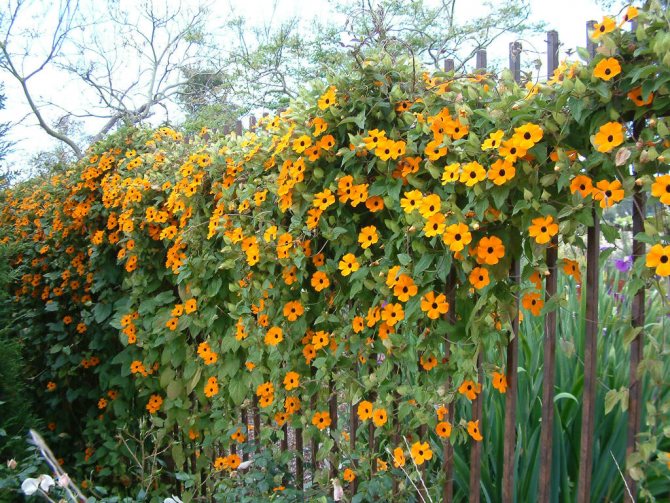

Liana will decorate the wall of any unsightly building, decorate the compost heap with its greenery. Summer residents love to plant tunbergia along fences, turning them into flowering walls. Used as a "carpet" in the inaccessible corners of the personal plot, on the slopes. Ampel plant varieties are planted in hanging pots, flowerpots and wicker baskets, decorating terraces, balconies and loggias.
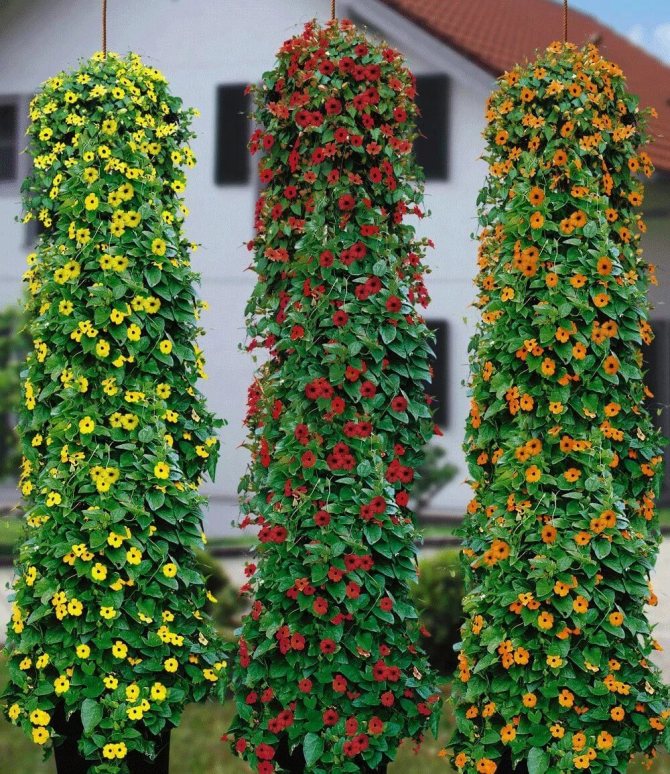

Thunbergia goes well with other climbing plants - ivy, morning glory, climbing asarina. The plant will delight you with green foliage and an abundance of flowers until late autumn, while retaining its decorative effect.
Diseases and pests
Often, tunbergia bushes or vines are affected by spider mites, scale insects or aphids. Treatment of the plant with chemical preparations, for example, actellik or phytoverm, helps to get rid of these insects. A break should be observed between procedures. No more than 4 treatments are allowed. There are cases of infection with fungal diseases. Fungicides will cope with this problem. As soon as the first signs of infection become noticeable, diseased leaves and inflorescences are destroyed.
Sometimes a mold plaque forms on the stems, which indicates excessive waterlogging of the soil. If there is little foliage on the shoots, then the area where the tunbergia is grown is lacking lighting.
How to collect your seeds
After ripening, the fruit capsule opens, the seeds spill out on the ground. This feature of the plant makes it difficult to collect seeds. It is necessary to harvest the fruits when the flower is in a semi-wilted state. The seeds are already fully ripe, but do not spill out, because the fruit shell is not completely dry. The boxes are collected, laid out on a light cloth or paper, and placed in a sunny place. After drying, the seeds are collected and stored in a dark, dry place. Seeds retain their germination capacity for no more than 2 years, after this period, tunbergia is not grown from old seeds, germination drops by 50%.
Planting tunbergia in open ground
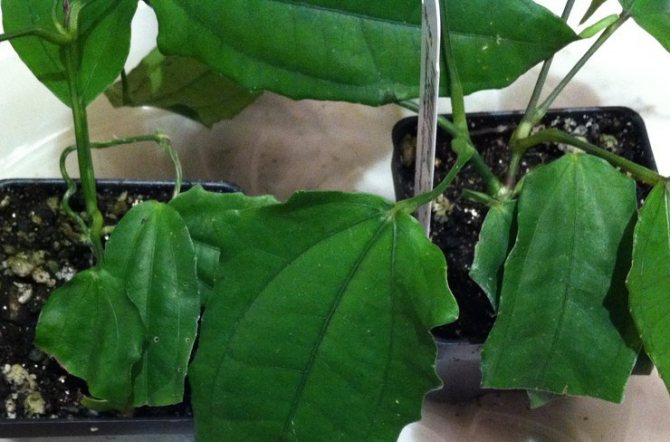

When to plant tunbergia
After the spring frosts recede, you can send the seedlings to the flower bed. The landing site should be in the shade. Drafts should be avoided. As a substrate, choose a fertile soil with good drainage properties and a neutral environment. Before planting, the site is dug up, while a small amount of lime is added to the soil.
How to plant correctly
It is necessary to plant individual specimens of tunbergia at a distance from each other, which should be at least 30 cm.To further the shoots can cling and stretch upward, support gratings or wire are installed on the site. The flowering of seed-grown tunbergia occurs three months after the pinching of the tops.
Temperature
From spring to autumn, the optimal temperature for tunbergia will be 20-25 degrees.
It is important that the room in which the tunbergia is located is well ventilated. But it should be remembered that the vine is afraid of drafts and cold air.
Starting in October, the temperature of the content should be gradually reduced, so that in winter it is within 12-16 degrees.Thus, a relative dormant period sets in, and growth gradually slows down.
It is important to know that Tunbergia is very thermophilic.
In the warm season, the flower can be taken out into the fresh air, for example, on a veranda or balcony. However, it is important to ensure that the plant does not fall on the direct rays of the sun, there are no drafts and wind.
If the plant will grow in the garden, then it should be planted only when warm weather is established - in late May - early June. Otherwise, the tunbergia will take root for a very long time or even die. Tunbergia flower does not tolerate winter in the garden.
The soil
For tunbergia, a loose, light soil with an acidity of 6.0 pH is suitable. You can buy a ready-made substrate for decorative flowering plants.
It will be nice to prepare the soil yourself. In this case, sod, leafy soil, peat, humus and sand should be mixed in equal parts.
Another option is sod land, humus and sand in a 2: 2: 1 ratio.
Before planting, the soil should be disinfected, for example, by spilling with a weak solution of potassium permanganate. The pot should have drain holes, and it is important to lay a drainage layer on the bottom.
Description of the plant
Thunbergia is represented by more than 200 species, between which there are significant differences. First of all, plants are shrubby and vines. Shrub varieties grown as perennials mainly in tubs and pots. The most popular of this category are tunbergias - upright, Natal, Vogel's tunbergia.
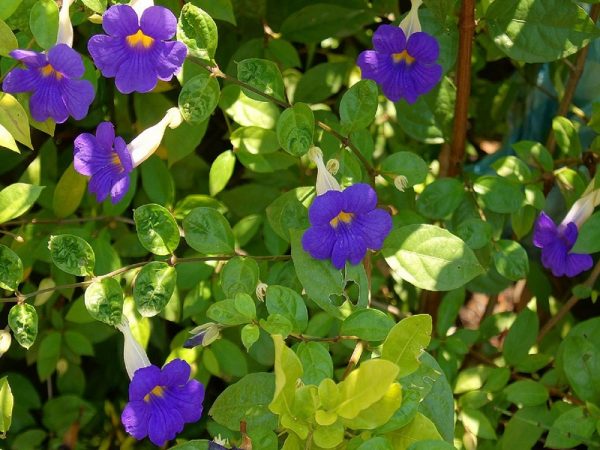

Tunbergia erect
Liana plants cultivated as annuals in open-air flower beds. In Russia, curly tunbergias are most in demand - winged, large-flowered, mizorenskaya, laurel and etc.
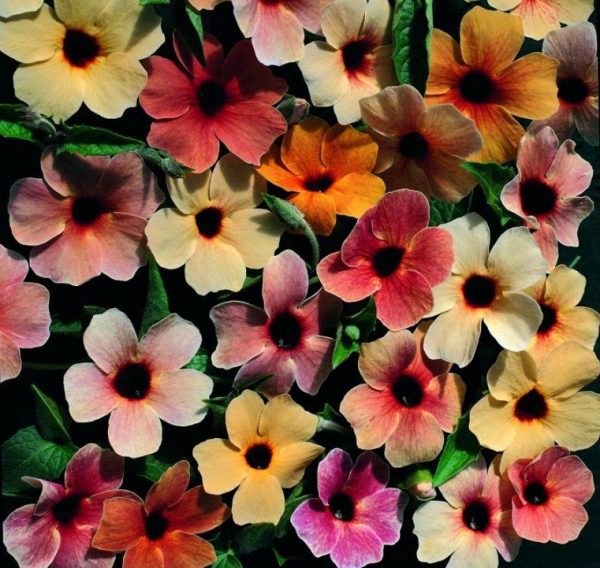

Thunbergia winged
Vine scourges can be up to 2.5 meters long. This mainly depends on the height of the support. In summer, funnel-shaped flowers appear on the plant, reaching a diameter of 4 cm. They are located singly or form inflorescences. The flowers have five petals collected in a tube. The color palette is very wide - from white and yellowish to purple, orange. The pharynx of the flower may be deep purple. This creates the effect of the eye - for example, in the variety Black eyed suzanne.
Pollination is carried out only with the help of insects. With the arrival of autumn, the vine stops flowering. Then the boxes with seeds inside ripen. The seeds are rather large, up to 4 mm in diameter, with a rough surface.
It is interesting. Some types of tunbergia have specialization. Thus, pollination in large-flowered varieties occurs only when interacting with Xylocopa lapites bees.
Tunbergia has a rather large rhizome and a branched ground part. Leaves are found in two types - lobed, opposite or whole, heart-shaped, ovoid.
Video - Thunbergia
Fertilizer
Tunbergia is fed from April to September, once every 2-3 weeks.
For this purpose, it is optimal to use liquid fertilizers for decorative flowering plants.
Top dressing should be done in moist soil to avoid root burns.
In winter, you do not need to fertilize Tunbergia.
In order to stimulate the growth of the flower and increase the green mass, it is recommended to feed the tunbergia with fertilizers with a high nitrogen content in the spring during the period of active growth. However, during the period of budding and flowering, nitrogen-containing fertilizing cannot be used. Otherwise, flowering will be very poor.
Wintering
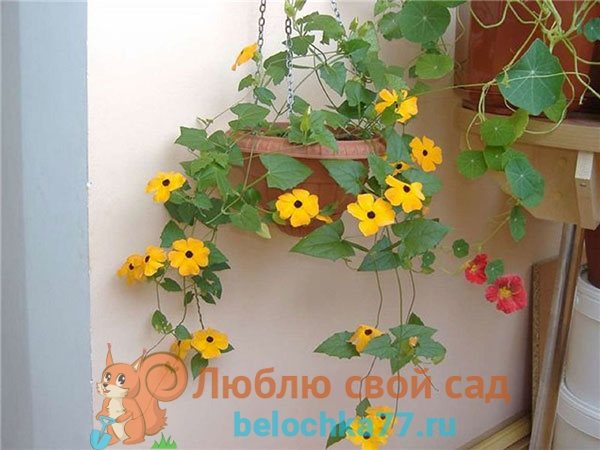

Liana growing in flowerpots is brought into a cool room (15 ° C). Most of the shoots are cut off. The remaining branches should have no more than 5 buds. Each slice must be disinfected; a pink solution of manganese is suitable for this purpose.
During the winter, occasionally moisten only the top layer of the earth. It makes sense to dispose of a liana growing in the ground; in any case, it will not withstand the winter. If you have time and desire, then the bush can be cut and transplanted into a large flowerpot.Store until spring according to the scheme already described.

